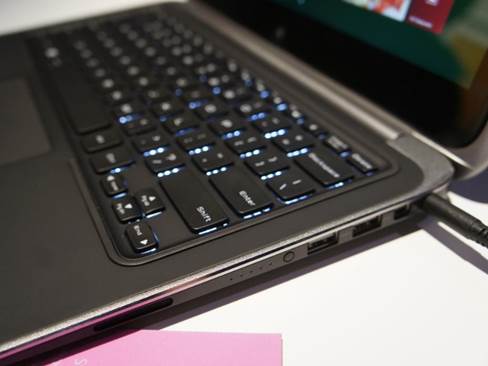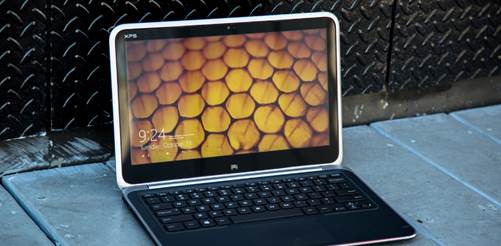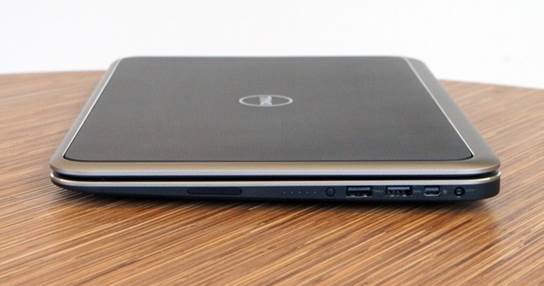Keyboard and trackpad
As you would expect, the keyboard is
basically the same as that of the XPS 13, but it is only slightly smaller. Even
in this narrower chassis, the keyboard layout is still large and easy to find
by feel. As we always say, it feels like the buttons are placed on a spring,
bringing plenty of tactile feedbacks. Especially compared to other
ultraportables whose the majority of the keys are shallow, lifeless, they are
fun to type. It is also noteworthy: the keyboard is backlit, which you can turn
on or off using the F5 button.

The
keyboard is basically the same as that of the XPS 13.
The XPS 12’s Cypress Trackpad suffers from
schizophrenia: it is smooth and reliable in Modern UI, but then stubborn and
capricious in traditional desktop. We do not have any problems in the use of
two fingers to scroll through the Live Tiles. The touchpad supports Windows 8
gestures, such as swiping from the right side of the pad to reveal the Charms
Bar, or swiping from the left to switch between applications. The Pad is good
at all of this; these gestures are intuitive and easy to replicate.
Where we had trouble was simple navigation
with the pointer. While using desktop applications such as Explorer, we found
that sometimes it needed multiple attempts to put the cursor right where we
wanted it to be. Other times, the cursor on the screen paused before we got to
wherever we were trying to click. Even in Modern UI, navigating with a finger
could feel a little inconvenient. On the positive side, the trackpad’s
pre-installed touch button is easy to press, and it may not be confused with
the right-left click – which we often complain when checking the touchpad
without buttons. In any case, a Dell representative told us the company is
still tweaking drivers, so perhaps this problem will soon become indisputable
points.
Display and sound

In
the case of the 12.5-inch screen of the XPS 12, the 1080p resolution shows the
density of 176ppi.
Even on 14-inch and 15-inch PCs, we often
see a screen with a resolution of 1,366x768, so it is always surprising to see
these small systems like the XPS 12 or the Zenbook Prime UX21A with the display
of 1,920x1,080 pixel packed in an 11-inch or 12-inch screen. In the case of the
12.5-inch screen of the XPS 12, the 1080p resolution shows the density of 176ppi
(compared to 118ppi on the XPS 13). As you waited, it was quite lively. We
would lie on saying that you can notice a big difference when viewing a
particular movie on Netflix, but if the content was recorded in 1080p, it will
be great. The additional pixels also make a difference in desktop applications,
where everything seems to be a little tighter, and the items on the screen look
significantly smaller. In addition, 400-nits brightness means you certainly
will not lack a consistent viewing angle. Even with average brightness, you
will have a good straight viewing angle while placing the device on your lap.
This indicates a good omen for travel by air, or any condition of "movement."
Thanks to the Gorilla Glass layer, it is
also durable enough to be used in tablet mode. As a touchscreen, it reacts
quickly with pinch-to-zoom gestures, while the Windows 8 apps such as Photos
and IE 10 do a good job in quickly resizing the content. The only prediction for
us is that the screen brightness drains up the battery, at only 400 nits, it is
almost on a par with the other laptops, even at moderate settings.
Like so many other ultraportable laptops,
the XPS 12 has some real limitations in the field of sound. The only surprising
thing is how loud it is, and how small the distortion is at maximum volume. On
the other hand, this is the story you've heard before: the bass voice is often
drowned and the only thing you can do is to increase the volume to compensate
for that. On the positive side, things like piano and guitar often sound quite
interesting.
Performance and battery life
We are at the time when PCs are really
fast; there is nothing unusual when an Ultrabook with 4GB of RAM and an SSD
drive boots in less than 20 seconds. We still pretend to be surprised on
recording the launch time of the XPS 12. It only takes 12 seconds to get to the
login screen, and another two seconds to load on the Start Menu after you've
entered credentials. Samsung's SSD also proved to be promising: in the ATTO
test drive, it reached a maximum read speed of 516MB/s, it is placed on the
same level with our favorite ultraportables, 13-inch MacBook Air and includes
13-inch Samsung Series 9. The write speed was also high, reaching 263MB/s. In
real use, this performance allows us to switch between applications with ease,
and not to have to keep track of how many applications we are running on it.
Regarding graphics, it reached 4520 in 3DMark06, on a par with or slightly
better than the other Ivy Bridge Ultrabooks we've tested.

We
are at the time when PCs are really fast; there is nothing unusual when an
Ultrabook with 4GB of RAM and an SSD drive boots in less than 20 seconds.
In PCMark 7, the XPS got 4,673 scores, but
we admitted we can't make much of that score right now, because we recently begun
to move from PCMark Vantage to PCMark 7 (the latter only runs on Windows 8 –
because it was the shift in testing methodology). When we evaluated more
Windows 8 systems using PCMark 7 as a general performance test, we would easily
put these scores into more context.
After running the standard battery test
multiple times, 5 hours and a half was the longest time that the XPS 12 could
last. As you can see, it is not impressive, given that these other Ultrabooks
can reach 6 hours or more. However, it is interesting that it is on a par with
the Toshiba Satellite U925t, a 12.5-inch touchscreen Ultrabook. We are still in
the process of testing it, but basically we found its run even shorter: about 5
hours 10 minutes.